Related Research Articles

Albert Paul Mantz, known as Paul Mantz, was a noted air racing pilot, movie stunt pilot and consultant from the late 1930s until his death in the mid-1960s. He gained fame on two stages: Hollywood and in air races.

Hell's Angels is a 1930 American pre-Code independent epic war film directed and produced by Howard Hughes and director of dialogue James Whale. Written by Harry Behn and Howard Estabrook and starring Ben Lyon, James Hall and Jean Harlow, it was released through United Artists. It follows two dissimilar brothers, both members of the British Royal Flying Corps during the First World War.

Florence Lowe "Pancho" Barnes was a pioneer aviator and a founder of the first movie stunt pilots' union. In 1930, she broke Amelia Earhart's air speed record. Barnes raced in the Women's Air Derby and was a member of the Ninety-Nines. In later years, she was known as the owner of the Happy Bottom Riding Club, a bar and restaurant in the Mojave Desert, Southern California, catering to the legendary test pilots and aviators who worked nearby.

Frank Gifford Tallman III was a stunt pilot who worked in Hollywood during the 1960s and 1970s. He was the son of Frank Gifford Tallman, Jr. and Inez Evelyn Foster.
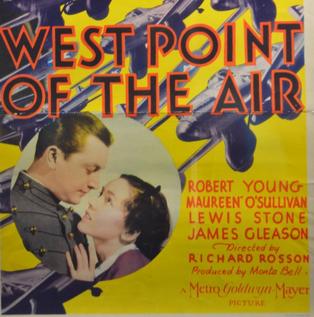
West Point of the Air is a 1935 American drama film directed by Richard Rosson and starring Wallace Beery, Robert Young, Lewis Stone, Maureen O'Sullivan, Rosalind Russell, and Robert Taylor. The screenplay concerns pilot training in the U.S. Army Air Corps in the early 1930s.
Stunt flying refers to any stunts performed in an aircraft. It encompasses aerobatics, wing walking, and transferring from one airplane to another or to a moving vehicle on the ground, such as an automobile or train, and vice versa.

Flying G-Men is a 15-episode 1939 adventure film Film serial, directed by James W. Horne and Ray Taylor. The serial was the sixth of the 57 serials released by Columbia.Four "Flying G-Men" battle with enemy saboteurs intent on destroying American military defences.
Moye Wicks Stephens was an American aviator and businessman. He was a pioneer in aviation, circumnavigating the globe with adventure writer Richard Halliburton in 1931, and co-founding Northrop Aircraft, Inc.

Eagle of the Night is a 1928 American drama film serial directed by James F. Fulton. Dismissed when released and completely forgotten in the modern era, the 10-chapter aviation serial starred real-life aviator Frank Clarke, a stunt pilot in such fare as Wings (1927), Hell's Angel (1930), and The Flying Deuces (1939).

Air Mail is a 1932 American pre-Code adventure film directed by John Ford, based on a story by Dale Van Every and Frank "Spig" Wead. The film stars Ralph Bellamy, Pat O'Brien and Gloria Stuart. A copy is preserved in the Library of Congress.
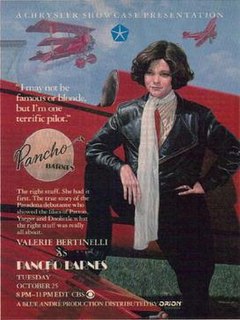
Pancho Barnes is a 1988 American made-for-television biographical film about the pioneering female aviator, starring Valerie Bertinelli, Ted Wass, James Stephens and Cynthia Harris. The film was directed by Richard T. Heffron and premiered on CBS on October 25, 1988.

The Lost Squadron is a 1932 American pre-Code drama, action, film starring Richard Dix, Mary Astor, and Robert Armstrong, with Erich von Stroheim and Joel McCrea in supporting roles, and released by RKO Radio Pictures. Based on the novel The Lost Squadron (1932) by Dick Grace, the film is about three World War I pilots who find jobs after the war as Hollywood stunt fliers. The much-later The Great Waldo Pepper (1975) employed a similar theme. The Lost Squadron was the first RKO production to carry the screen credit "Executive Producer, David O. Selznick".
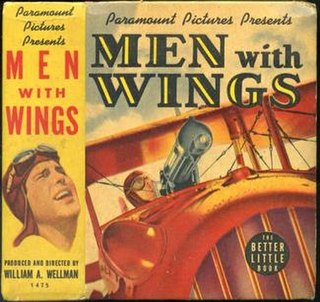
Men With Wings is a 1938 American Technicolor war film, directed by William A. Wellman and starring Fred MacMurray, Ray Milland, and Louise Campbell. Donald O'Connor also has a small part as the younger version of MacMurray's character. The two would soon star in the film Sing You Sinners together along with Bing Crosby.
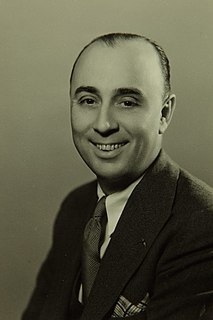
Wally Timm was an American aircraft designer, pilot and manufacturer.

Blaze of Noon is a 1947 aviation adventure film directed by John Farrow and based on writer and aviator Ernest K. Gann's best-selling novel Blaze of Noon (1946), a story about early air mail operations. The screenplay was from well-known writer and aviator Frank "Spig" Wead and Arthur Sheekman and starred Anne Baxter, William Holden, Sonny Tufts and William Bendix.

Flying Devils is a 1933 American Pre-Code action film dealing with aviation. The film was directed by former Hollywood agent Russell Birdwell and photographed by film noir cinematographer Nicholas Musuraca. The screenplay was written by Byron Morgan and Louis Stevens, based on an original story by Stevens. In an unusual move, Bruce Cabot was the star, with perennial "good guy" Ralph Bellamy playing the villain in a love triangle involving Arline Judge and Eric Linden. Although considered a "B" feature, audiences enjoyed the aerial scenes, which helped elevate the feature to a minor box-office hit.

Sky Bride is a 78-minute 1932 drama film, produced by Paramount Pictures and directed by Stephen Roberts. The film stars Richard Arlen, Jack Oakie and Virginia Bruce. Sky Bride depicts the life of barnstorming pilots flying in the years following World War I. All over North America, skilled pilots, many of them veterans of the aerial combat of World War I, plied their trade on the barnstorming circuit of the 1920s in small towns where impromptu air shows were staged.
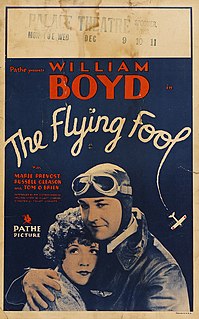
The Flying Fool is a 1929 aviation-themed film produced and distributed by Pathé Exchange as both a silent film and sound film just as Hollywood was transitioning to filming with sound. Tay Garnett directed and William Boyd, Russell Gleason and Marie Prevost starred.

Frank Clarke was a Hollywood stunt pilot, actor, and military officer. His most prominent role was as Leutnant von Bruen in the 1930 production Hell's Angels, but he flew for the camera and performed stunts in more than a dozen films in the 1930s and 1940s. Clarke was killed in an aircraft crash near Isabella, California, in 1948.

Flying Romeos is a 1928 American comedy adventure directed by Mervyn LeRoy and written by John McDermott, Sidney Lazarus, Gene Towne and John W. Conway. The film stars the comedy team of Charles Murray and George Sidney, stars of Universal's popular "The Cohens and Kellys" comedies, moonlighting at First National Pictures. Other sidekicks included Fritzi Ridgeway, Lester Bernard, Duke Martin, James Bradbury Jr. and Belle Mitchell. Flying Romeos was released on February 26, 1928, by First National Pictures, typically a B movie studio.
References
- Notes
- 1 2 Kelly, 2008, p. 8
- 1 2 Kelly, 2008, p. 46
- 1 2 3 4 5 Centennial of Flight. Hollywood Stunt Pilots. Archived August 26, 2009, at the Wayback Machine Retrieved on November 28, 2009.
- 1 2 3 Kelly, 2008, p. 9
- 1 2 Vreeland, Frank. Foremost films of ...: a yearbook of the American screen, p. 20. Pitman Pub. Corp., 1938.
- ↑ Borradaile, Osmond and Anita Hadley. Life through a lens: memoirs of a cinematographer, p. 33. McGill-Queen's Press - MQUP, 2001. ISBN 0-7735-2297-2
- ↑ Kelly, 2008, p. 112
- ↑ The American Film Institute catalog of motion pictures produced in the United States, Volume 1, Part 2, pp. 773–774. University of California Press, 1993. ISBN 0-520-07908-6
- ↑ Time magazine, February 6, 1933. "Cinema: Little Cinema." Retrieved on November 29, 2009.
- ↑ Internet Movie Database. Men with Wings (1938). Retrieved on November 29, 2009.
- Bibliography
- Kelly, Shawna. (2008) Aviators in Early Hollywood. Arcadia Publishing. ISBN 0-7385-5902-4